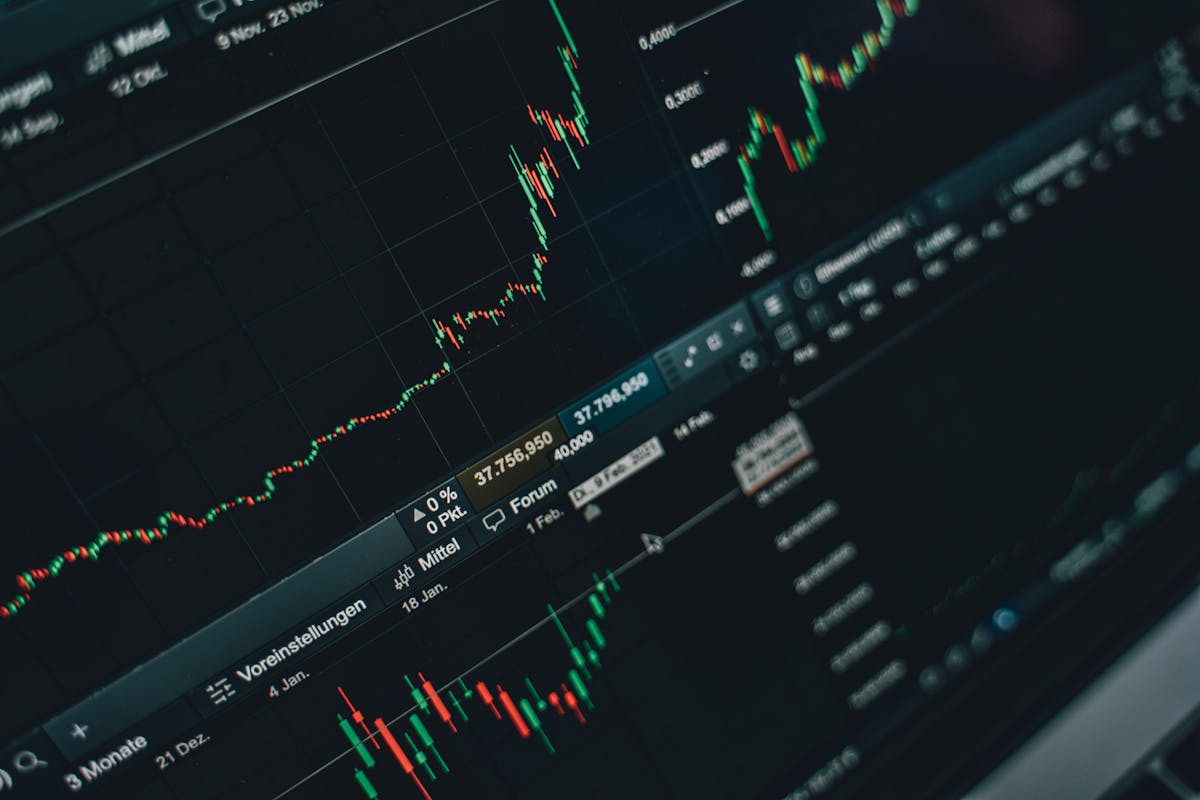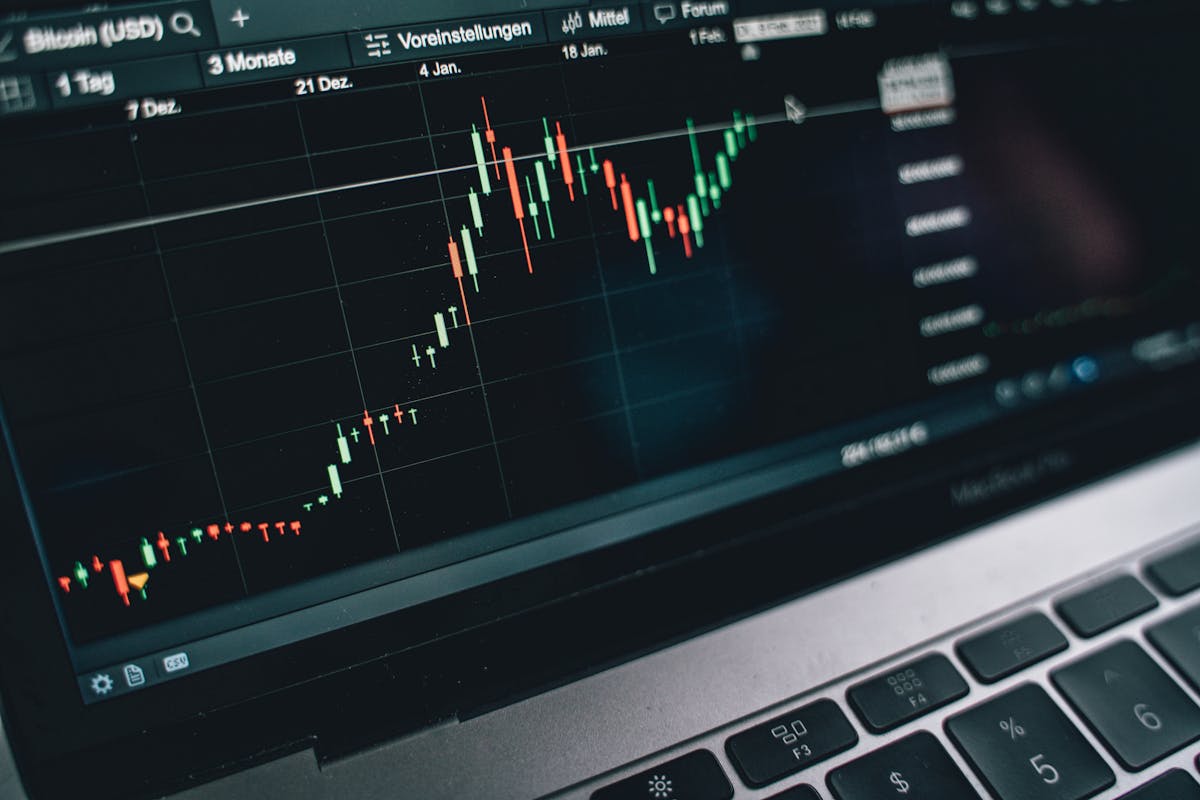Smart Investing in 2025: How Everyday People Build Wealth with AI and ETFs
Investing has never been more accessible — or more intelligent. In 2025, Artificial Intelligence (AI) and Exchange-Traded Funds (ETFs) are not just for Wall Street professionals. Everyday people are now using smart algorithms to manage money, predict market movements, and grow wealth faster than ever before.

Why 2025 Is the Year of Smart Investors
Between rising inflation, global uncertainty, and rapid tech advancements, investors are seeking stable, automated, and data-driven strategies. AI tools now analyze thousands of stocks, ETFs, and cryptocurrencies within seconds — helping you build portfolios that match your goals, not your guesswork.
- 📊 AI-driven analysis: Algorithms monitor trends and news 24/7.
- 💡 Personalized insights: Platforms like Betterment and Wealthfront use AI to tailor portfolios.
- ⚙️ Auto-rebalancing: No need to manually adjust assets — the system does it for you.

The Rise of ETF Investing
Exchange-Traded Funds (ETFs) are now the foundation of modern portfolios. Why? Because they combine diversification, liquidity, and low fees — the golden trio for consistent returns.
Top-performing ETFs in 2025 focus on emerging industries like:
- 🧠 AI & Robotics – Global X Robotics & AI ETF (BOTZ)
- 🌿 Clean Energy – iShares Global Clean Energy ETF (ICLN)
- 🏡 Real Estate – Vanguard Real Estate ETF (VNQ)
- 💰 Dividend Growth – Schwab U.S. Dividend Equity ETF (SCHD)

How AI and ETFs Work Together
Imagine an investor using AI to track which ETFs are gaining momentum — then automatically allocating money toward those funds.
This hybrid strategy is called “AI-guided passive investing.” It’s becoming a favorite for both beginners and professionals because it reduces emotion-based decisions.
“In 2025, emotionless investing beats emotional guessing.”
Key Benefits of Smart Investing in 2025
- 📈 Real-time market monitoring — 24/7 updates on global shifts.
- 📊 Automatic diversification — protect against market crashes.
- 💵 Low-cost management — no hidden fees, no human bias.
- 🔄 Continuous optimization — your portfolio grows while you sleep.
And best of all — AI doesn’t panic during market dips. It adjusts. It learns. It improves.

Investing Platforms Leading the Revolution
In 2025, these platforms dominate the U.S. market for AI-based investing:
- 🧠 Betterment — best for automated ETF investing.
- 💼 Wealthfront — ideal for goal-based portfolios.
- 📊 Public.com — social investing meets analytics.
- 🚀 M1 Finance — advanced customization and “pie” investing.
Real Success Story: The $500 Challenge
In 2025, a Reddit user named “MiaInvests” started with just $500 on M1 Finance. By using AI-guided ETFs and auto-investing $50/month, she reached $4,200 in one year — with zero trading knowledge.
Her key strategy?
- She automated everything.
- She never checked her portfolio daily.
- She let AI rebalance quarterly.
That’s the power of patience + automation.

Next → Part 3 and 4 will explore: “How to Build a Smart ETF Portfolio with AI (Step-by-Step)” and “Top Mistakes New Investors Make in 2025.”
How to Build a Smart ETF Portfolio with AI (Step-by-Step)
Building an AI-powered ETF portfolio in 2025 doesn’t require a finance degree — you just need structure, discipline, and a few digital tools that do the heavy lifting for you.

Step 1: Define Your Financial Goals
Before you invest, clarify what you’re investing for — is it retirement, a house, or passive income? Your goal determines your timeline, risk level, and asset mix.
- 🎯 Short-term (1–3 years): Stick to lower-risk ETFs (bonds, dividend funds).
- 📈 Medium-term (3–7 years): Mix stocks, real estate, and AI innovation ETFs.
- 🚀 Long-term (10+ years): Focus on growth ETFs (tech, global, emerging markets).

Step 2: Choose the Right AI Platform
AI platforms eliminate guesswork. The key is to pick one that matches your investing style.
- 💼 Wealthfront: Best for beginners who want automation and tax optimization.
- 📊 M1 Finance: Great for hands-on investors who like to customize “slices.”
- 🤖 Betterment: Perfect for long-term investors wanting minimal management.
- 📱 Public.com: Combines social investing with AI-driven insights.

Step 3: Diversify Your ETF Portfolio
Diversification is the golden rule. Even AI can’t predict which industry will boom next — but spreading your assets increases your odds of success.
A balanced 2025 portfolio might look like this:
| Category | Example ETF | Allocation % |
|---|---|---|
| Technology | Vanguard Information Tech ETF (VGT) | 25% |
| Clean Energy | iShares Global Clean Energy ETF (ICLN) | 15% |
| Healthcare | SPDR S&P Biotech ETF (XBI) | 10% |
| Real Estate | Vanguard Real Estate ETF (VNQ) | 10% |
| AI & Robotics | Global X Robotics ETF (BOTZ) | 10% |
| U.S. Bonds | iShares Core U.S. Aggregate Bond ETF (AGG) | 30% |

Step 4: Let Automation Handle the Rest
Once you’ve built your ETF portfolio, AI handles:
- 🔄 Automatic rebalancing every quarter.
- 💰 Reinvesting dividends into the highest-performing assets.
- 📉 Minimizing taxes through intelligent loss harvesting.
That’s why investors in 2025 no longer check the market every morning — they let the algorithms do the worrying.
Top Mistakes New Investors Make in 2025 (and How to Avoid Them)
Even with the best tools, many new investors still stumble. AI can’t fix emotional or behavioral mistakes — that’s up to you.

1. Checking Your Portfolio Daily
Markets move fast — but that doesn’t mean you should. Frequent checking leads to panic-selling during dips. Remember: time in the market beats timing the market.
2. Ignoring Diversification
Putting all your money in one stock or ETF might work short-term, but long-term investors spread risk across industries and geographies.
3. Overreacting to News
AI-driven portfolios ignore emotional decisions. Humans, on the other hand, tend to sell when headlines sound scary. Don’t let short-term noise destroy long-term goals.
4. Chasing High Returns Only
Investing isn’t about luck — it’s about consistency. Some of the best investors make moderate but steady profits year after year.
5. Forgetting the Tax Impact
Smart investors in 2025 use tax-loss harvesting to offset gains. It’s one of the easiest ways to save thousands annually — and most AI platforms do it automatically.
Next → Part 5 and 6: We’ll dive deeper into emerging investment technologies like blockchain-backed ETFs, AI prediction tools, and real case studies of people who doubled their wealth using automation.
Emerging Investment Technologies in 2025
The investment landscape is evolving faster than ever. In 2025, it’s no longer just about buying and holding — it’s about integrating technology into every decision.
New tools, platforms, and financial ecosystems are giving investors more power than at any other time in history.
1. Blockchain-Backed ETFs
One of the biggest innovations of 2025 is the introduction of blockchain-backed ETFs. These funds use blockchain to provide transparent ownership records, instant settlements, and 24/7 accessibility.
- 🔗 Transparency: Investors can verify holdings in real-time.
- ⏱️ Speed: Settlement times drop from two days to a few minutes.
- 🧾 Security: Decentralized ledgers prevent tampering or fraud.

2. Predictive Analytics and AI Forecasting
AI-powered forecasting models can now predict market trends days or weeks before they happen. These systems process billions of data points — from social media sentiment to commodity flows — and convert them into actionable insights.
Platforms like TradeAlgo, Kavout, and Tickeron already use predictive algorithms to identify high-probability trades for both institutional and retail investors.
- 📊 Predicts market volatility levels.
- 📉 Detects overvalued assets before corrections.
- 📈 Identifies early growth trends before mainstream media does.

3. Fractional Investing and Micro Portfolios
In 2025, you don’t need to be rich to invest like the rich. Platforms now allow you to buy fractions of ETFs, stocks, or even AI funds — sometimes starting from as little as $1.
This is called micro investing, and it’s revolutionizing how younger generations build wealth. Apps like Acorns and Robinhood are leading this movement.
- 💸 Start with small amounts.
- 🔁 Automate contributions weekly.
- 📈 Watch compounding take over.

4. AI-Powered Risk Management
AI doesn’t just help you make money — it helps you protect it. Advanced systems now monitor portfolios for signs of overexposure, volatility, or liquidity risk.
When the market changes, AI instantly reallocates assets to maintain your preferred risk level. It’s like having a personal financial bodyguard working 24/7.

Real Case Studies: Everyday Investors Using AI to Build Wealth
Let’s move from theory to reality. Here are a few success stories from 2025 showing how AI investing is changing real lives.

Case Study 1: The Freelance Designer
Jenna, a 31-year-old freelance designer from Austin, Texas, started with $1,000 on Wealthfront. She let the AI system manage her ETF portfolio while contributing $200/month.
- 📅 Duration: 18 months
- 📈 ROI: +21%
- 📊 Risk profile: Moderate
Her secret? She never touched her investments — and trusted automation to handle everything.

Case Study 2: The Small Business Owner
Mark, a café owner from Chicago, wanted to invest his profits but had no time to study markets. He chose M1 Finance and built a “Smart Pie” combining AI, energy, and real estate ETFs.
- 💵 Starting capital: $5,000
- 🧠 Strategy: AI + Clean Energy ETFs
- 📈 Result after 1 year: +27% return
“It felt like having a Wall Street team in my pocket,” Mark says. He reinvested profits to expand his café.

Case Study 3: The Retiree Investor
David, 64, retired early and wanted stable income with minimal risk. He used Betterment to build a retirement-focused ETF mix — balancing dividend stocks, bonds, and real estate funds.
- 🏦 Portfolio size: $150,000
- 📉 Risk level: Conservative
- 💰 Annual income yield: 4.5%
“I sleep better at night knowing AI handles everything,” he said.

Next → Part 7 and 8: We’ll explore how to identify the next generation of growth ETFs, and the ultimate strategy to combine AI, ETFs, and human intuition for unstoppable long-term results.
How to Identify the Next Generation of Growth ETFs
In 2025, the smartest investors don’t just follow the market — they anticipate it. The new wave of wealth is being built around emerging industries and AI data patterns that signal what’s next.

1. Track the “Technology of Tomorrow” Sectors
The fastest-growing ETFs in 2025 focus on sectors that didn’t even exist ten years ago. AI now scans thousands of datasets to identify where future growth is accelerating most.
- 🧠 Artificial Intelligence & Automation — demand across industries continues to surge.
- 🔋 Clean Energy & EV Infrastructure — supported by U.S. and EU green funding.
- 🧬 Biotech Innovation — breakthroughs in genetics and personalized medicine.
- 🌐 Cybersecurity — protecting AI, IoT, and data centers from evolving threats.
- 🏘️ Smart Real Estate — AI-managed property portfolios and real-time rent analytics.

2. Study Institutional Investment Flows
Follow the money — literally. Institutional investors and pension funds often invest in new ETFs months before retail traders catch wind of them.
AI-driven tools like WhaleWisdom and Bloomberg Terminal AI now reveal exactly where these funds are going.
- 💼 Track quarterly 13F filings for early signs of inflows.
- 📈 Analyze fund size growth (AUM) over 6–12 months.
- 🔍 Watch for consistent volume spikes on low-cost ETFs.
3. Use AI Sentiment Scanning
In 2025, machines can read emotions better than humans. AI sentiment tools like MarketPsych analyze global news, tweets, and reports to gauge investor confidence.
When the sentiment toward a sector rises 15–20% consistently, it often signals early growth potential.
- 📰 Track news sentiment across financial outlets.
- 💬 Monitor social platforms like X (Twitter) and Reddit finance threads.
- 📉 Look for emotional spikes — both fear and excitement — to identify momentum.
4. Evaluate Expense Ratios and Liquidity
Even the smartest ETF can fail your portfolio if it’s too expensive or illiquid. Focus on funds with low management fees (below 0.50%) and high daily volume.
- 💰 Expense Ratio: The cost of holding an ETF annually.
- 💧 Liquidity: The ability to buy/sell without price slippage.
- 🧾 Spread: Smaller spreads mean lower transaction costs.
The Future of Hybrid Intelligence Investing
AI is incredible — but combining it with human intuition creates something unstoppable: Hybrid Intelligence Investing.
This method blends machine learning data with human experience and emotional intelligence to maximize results.

How It Works
- AI scans global financial data to identify trends.
- Investors interpret social, cultural, and policy shifts to validate them.
- Decisions are made combining both — data precision + human foresight.
This hybrid approach leads to better diversification, reduced emotional bias, and higher adaptive performance in uncertain markets.
Example: AI + Human Collaboration
Imagine AI detects growing interest in clean water technology ETFs. A human investor then reviews government infrastructure bills, environmental data, and climate policies — confirming the trend is real.
This combination ensures smarter, more validated investing decisions.
Why Hybrid Intelligence Beats AI Alone
- 🧠 AI sees patterns — but humans understand the “why.”
- 💬 Humans detect culture shifts — AI can’t always read global emotion perfectly.
- 💼 AI executes fast — humans validate ethical, political, and long-term impacts.
It’s no longer “man vs. machine.” It’s man + machine — the most profitable partnership in the financial world.
Next → Final Parts (9 & 10): We’ll close the article with the ultimate roadmap for 2025 investors — how to create a lifetime wealth plan using AI, ETFs, and behavioral mastery.
The Ultimate Roadmap to Smart Investing (2025–2030)
We’ve explored how AI, ETFs, and automation are rewriting the rules of investing. Now, let’s put everything together into a simple, powerful strategy that can turn even a beginner into a confident investor by 2030.

Step 1: Automate Your Savings
Wealth begins with habit, not luck. Set up automatic transfers to your investment account every month — even if it’s just $100. AI systems like Betterment or M1 Finance will invest it for you automatically.
- 💳 Automate deposits after each paycheck.
- 📆 Treat investing as a bill you must pay to your future self.
- 📈 Watch your wealth grow passively through compound interest.
Step 2: Build a Core ETF Portfolio
Your foundation should include a blend of low-cost ETFs that represent global markets. This ensures you always benefit from worldwide growth while minimizing risks.
- 🌎 Global Equity ETFs — track major markets like the S&P 500 and MSCI World.
- 🏦 Bond ETFs — add stability during market downturns.
- 🏘️ Real Estate ETFs — generate passive income through dividends.
- 🔋 Innovation ETFs — capture new opportunities in AI, biotech, and clean energy.

Step 3: Add AI Tools to Optimize Performance
Let AI handle the complexity. Use robo-advisors, predictive analytics, and real-time insights to optimize returns without needing to monitor the market daily.
- 🤖 AI Advisors: Automate rebalancing and tax harvesting.
- 📊 Analytics Tools: Predict trends and recommend portfolio shifts.
- ⚙️ Machine Learning: Detects inefficiencies and hidden opportunities.

Step 4: Master Your Behavior
The biggest enemy of success isn’t market volatility — it’s emotional volatility. To build wealth long-term, learn to control reactions during market dips.
- 🧘 Patience: Time in the market always beats timing the market.
- 🧠 Discipline: Stick to your plan no matter the noise.
- 📉 Perspective: Every dip in history was temporary — every recovery, permanent.

Step 5: Think Long-Term (2025–2030 and Beyond)
Most people underestimate what they can achieve in five years of consistent investing. By 2030, today’s small contributions could grow into a life-changing portfolio.
- 💵 $100/month → ~$8,000 (at 8% annual return)
- 💵 $500/month → ~$40,000
- 💵 $1,000/month → ~$80,000+
And that’s without counting reinvested dividends or additional income sources.

The Future of Investing Is Here — Will You Adapt or Be Left Behind?
For decades, investing felt intimidating — reserved for Wall Street elites. But in 2025, technology has leveled the playing field. With AI, ETFs, and automation, the power to grow wealth is now in everyone’s hands.
Whether you’re a student, freelancer, or retiree, the formula is simple:
- 🎯 Start now — the best time to invest was yesterday.
- 💡 Automate — remove emotion and guesswork from your process.
- 🏦 Diversify — let your portfolio work across multiple sectors.
- 🧠 Adapt — use AI tools to stay ahead of the curve.
Conclusion: Your 2025 Wealth Manifesto
Here’s the truth, Faris — wealth doesn’t come from taking big risks; it comes from making smart, consistent moves that compound over time.
AI gives you the insight. ETFs give you the stability. But discipline gives you the freedom.
“The best investment decision you’ll ever make is to start — and never stop.”
So, whether you invest $50 or $5,000 — start today, automate your plan, and let the future of smart investing work for you.
